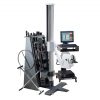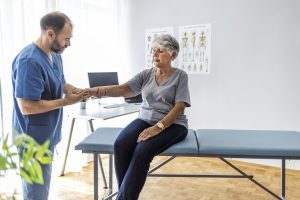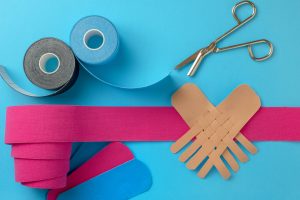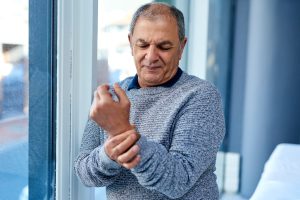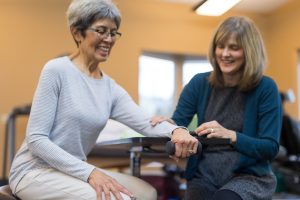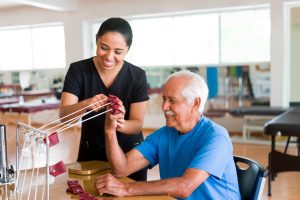
DeQuervain’s Tenosynovitis: Diagnosis, Treatment, and Management
Treatment GuidelinesTo identify DeQuervain’s, check for pain when there is pressure on the thumb and wrist. The Finkelstein test is the most common diagnostic tool for this injury. Treatment for DeQuervain’s includes hands-on techniques, therapeutic exercises, and home recommendations.
DeQuervain’s tenosynovitis is a condition that can turn life’s everyday activities into a wrist-wrenching challenge. This overuse injury can lead to pain and discomfort in tasks as simple as opening a jar, texting, or even waving hello. However, studies show significant improvement with therapy. One study cited a 92.9% success rate in decreasing pain with therapeutic treatment!1
Overview of DeQuervain’s Tenosynovitis
Of the many tendons that work together for hand and wrist movement, DeQuervain’s involves two that work in tandem. The abductor pollicis longus (APL) and extensor pollicis brevis (EPB) tendons attach forearm muscles to the base of the thumb.2 These tendons share a sheath that binds them. Usually, these tendons extend and abduct the thumb with no problem. However, repeated or overly forceful movements of the thumb and wrist can aggravate them.
As the amount of friction increases, the tendon sheath becomes inflamed. Repeated motions add to the swelling, and movement becomes constricted. As a result, there is pain during motion and even at rest.
Could you recall those hand and wrist anatomy terms? Try your hand at this fun Upper Extremity Anatomy Quiz!
Causes, Signs, Symptoms
DeQuervain’s is caused by overuse or aggravation of wrist structures. This can result from swelling, such as the kind caused by arthritis or other inflammatory conditions.3 It also may be caused by trauma or injury to the thumb or wrist. Overuse is another likely cause, possibly from hobbies, daily activities, or occupational use.
These activities may include sports that involve gripping a stick or racket, such as tennis or skiing. Hobbies such as gaming, gardening, or weightlifting could also contribute. Work activities may also lead to overuse when lifting heavy loads, typing, or using a hammer or other tools. Really, anything involving frequent and repeated grasping or gripping can cause DeQuervain’s. Some mothers even develop this condition by repeatedly lifting their new baby!4
The hallmark of DeQuervain’s is pain and discomfort along the thumb, wrist, and forearm. The pain may center over the two tendons along the outside of the wrist. Swelling and pain may also affect the wrist and the thumb. Pain will be present at rest but aggravated by movement, which may limit range of motion and strength. A snapping or catching sensation may accompany thumb movement, and numbness can occur.
Diagnosing DeQuervain’s
To identify DeQuervain’s, check for pain when there is pressure on the thumb and wrist. The Finkelstein test is the most common diagnostic tool for this injury. Instruct a patient to make a fist with the fingers wrapped around the thumb. Then, with the thumb side of the hand facing upward, bend the wrist down toward the floor. If pain is produced over the affected tendons, the test is positive. Significant pain indicates DeQuervain’s Tenosynovitis.7
Treating DeQuervain’s in Your Clinic
Treatment for DeQuervain’s includes hands-on techniques, therapeutic exercises, and home program recommendations. Conservative treatment is successful for the majority of patients.3 Your approach may include a combination of manual techniques, exercise, and at-home interventions.
In early sessions, you may need to address pain and swelling immediately. Modalities such as ice massage and cryotherapy can relieve pain. Ultrasound has also been proven to provide pain relief and diminish swelling. Additionally, low level laser therapy has demonstrated analgesic properties in some studies. Both low level laser therapy and ultrasound have also been shown to prevent recurrence of pain and decrease future triggering of pain and discomfort during recovery.8
Manual Therapy for DeQuervain’s
Manual therapy techniques have also been shown to have beneficial outcomes.9 Using manual techniques on the affected muscles can decrease the constant pull of the tendons and lead to greater progress in therapy sessions. Combining circular friction, cross fiber techniques, and longitudinal work can help resolve the extreme tightness.9 As muscle tightness decreases, pin and stretch can continue to lengthen the tissues. IASTM techniques, such as the Graston method or gua sha, can also reduce swelling and increase the ROM of the affected tissues.9
Therapeutic Exercises for DeQuervain’s
Therapeutic exercises to increase range of motion and strength can improve the functional use of the hand. Performing assisted thumb abduction and extension can be an effective stretch. Touching each finger to the thumb can increase functional movement abilities. In addition, performing wrist flexion and extension stretches can lengthen surrounding muscles.11
Once pain and swelling have decreased, strengthening can begin. Performing exercises with putty can strengthen the fingers and intrinsic muscles of the hand. Another helpful exercise is gripping and releasing a tennis ball to increase grip strength.3
Home Recommendations
If the patient experiences pain with certain activities, you may need to alter those tasks. Activity modification can reduce further aggravation of the affected areas. Finding new methods for performing hobbies or work activities can get patients back to their daily routines even while recovering.
Consider ways to improve ergonomics, such as maintaining neutral wrist positions, taking rest breaks, or switching arms used during an activity6. In severe cases, patients may need to avoid some activities until reaching a certain point in recovery.
Splinting is a great way to ensure home carryover and has been shown to relieve symptoms.12 An effective splint or brace can reduce pressure on the affected tendons, allowing them to rest and recover. Some like to use their splints while sleeping to improve their rest. If a splint is too cumbersome, kinesiology tape can have a similar effect.11 Kinesiology tape can help maintain a neutral position, decrease swelling, or address trigger points for pain.
Avoiding Recurrence
Because it is an overuse injury, DeQuervain’s has a high likelihood of recurrence. Training patients in the principles of ergonomics can help them avoid reinjury. Some of the most common ergonomic considerations include:
- Maintain upright posture while performing tasks
- Increase core strength and use that as a foundation of movement
- Keep a neutral wrist position while working
- Change positions and types of movements every 20 minutes
- Choose tools with a handle size that complements the hand and is in a comfortable shape
- Take breaks during work, or shift to different tasks, to avoid straining the same area for an extended amount of time
- Let pain be your guide, and stop when uncomfortable
- Give yourself time to recover after difficult or intensive activities 13
Conclusion
DeQuervain’s Tenosynovitis is a fairly common overuse injury, affecting thousands each year.4 However, it is easily treatable and preventable when considering ergonomic factors and utilizing activity modification along with traditional therapeutic interventions. In the rare cases when a case is more severe, corticosteroid injections and surgery may be indicated. Fortunately, most cases are easily addressed with a combination of rest, splinting, and home programs.
Sydney Moninger, COTA/L is an Occupational Therapy Assistant and freelance writer. She has more than 10 years of clinical experience working in pediatric, orthopedic, and geriatric settings. Most recently, she has been helping patients at a pain management center for orthopedic injuries. Sydney is passionate about patient education and increasing health literacy in the community, which is what got her started in her writing in the first place. She loves discovering new perspectives that improve her clinical practice, and connecting with others on LinkedIn or her Upwork page.
References
- Lang, K. et al. 2014. “Conservative Treatment of de Quervain’s Tenosynovitis in Occupational Therapy: A Retrospective Outcome Study”. Grand Valley State University. https://scholarworks.gvsu.edu/cgi/viewcontent.cgi
- “Extensor Pollicis Brevis”. 2023. Physiopedia. https://www.physio-pedia.com/Extensor_Pollicis_Brevis
- “De Quervain’s Tendinosis”. 2023. Cleveland Clinic. https://my.clevelandclinic.org/health/diseases/10915-de-quervains-tendinosis
- Zelman, D. “What’s de Quervain’s Tenosynovitis?”. 2022. WebMD. https://www.webmd.com/rheumatoid-arthritis/de-quervains-disease
- Pidgeon, T. “De Quervain’s Tenosynovitis”. 2022. OrthoInfo. https://orthoinfo.aaos.org/en/diseases–conditions/de-quervains-tendinosis/
- “De Quervain tenosynovitis”. 2023. Mayo Clinic. https://www.mayoclinic.org/diseases-conditions/de-quervain-tenosynovitis/diagnosis-treatment/drc-20371337
- “Finkelstein Test”. 2023. Physiopedia. https://www.physio-pedia.com/Finkelstein_Test
- Ferrara, E et al. “Physical Modalities for the conservative treatment of wrist and hand’s tenosynovitis: A systematic review”. 2020. Seminars in Arthitis and Rheumatism. https://doi.org/10.1016/j.semarthrit.2020.08.006
- Papa, J. “Conservative management of De Quervain’s stenosing tenosynovitis: a case report”. 2012. Journal of the Canadian Chiropractic Association. https://www.ncbi.nlm.nih.gov/pmc/articles/PMC3364060/
- Muscolino, J. 2017. “How do we treat De Quervain’s syndrome with manual therapy?” LMCE. https://learnmuscles.com/product/digital-comt-subscription/
- “De Quervains Tenosynovitis”. 2023. Digital Health and Care Wales. https://sbuhb.nhs.wales/hospitals/a-z-hospital-services/physiotherapy/musculoskeletal-physiotherapy/hand-wrist-pain/de-quervains-tenosynovitis/
- Coldham, F. “The use of splinting in the non-surgical treatment of De Quervains disease: a review of the literature.” 2006. NCBI. https://www.ncbi.nlm.nih.gov/books/NBK73300
- Moore, S. et al. “Practical Demonstrations of Ergonomic Principles”. 2011. CDC. https://stacks.cdc.gov/view/cdc/57870/cdc_57870_DS1.pdf

